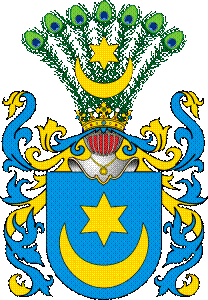|
|
UNDER THE WHITE
EAGLE An introduction to Polish
heraldry by Łukasz
Garczewski |
||||||||||||||
|
|
Just as each coat of arms is distinct, even
if only differenced by a single detail, each country’s heraldic rules and
practices have their own peculiarities. In many cases these differences can
be traced to historical events or underlying cultural differences.What
follows is a brief introduction to some of the more interesting quirks of
Polish heraldry that I hope will inspire you to explore Polish arms as well
as other European traditions. Ancient symbols All of the traditional heraldic charges can
be found in Polish coats of arms. The most prevalent being horseshoes,
crosses, arrows, mullets (stars) and crescents (the latter most probably due
to the many battles and skirmishes with the Turks of the Ottoman Empire). However, there are a few charges that are
peculiar and possibly entirely unknown outside the country. These geometric shapes, examples of which
are shown below, are believed to be the early tribal markings, once used to
mark possessions that evolved into coats of arms in early Middle Ages.
As equals The Polish nobility, called szlachta, was among the most numerous noble classes in
Europe. Interestingly, at the peak of its power, during the 17th and 18th
centuries, under the Polish-Lithuanian Commonwealth, members of the szlachta were all equals (at least in theory). There were
no aristocratic titles created: no counts, viscounts, and only a few
pre-existing dukedoms (exceptions made for a few select families). This principle of equality is a defining
factor of Polish nobility, as it was extended to a nobleman’s children. That
is: all lawful children of a noble were automatically considered their
father’s equals in status and, by extension, in their right to bear arms.
Indeed, all children had the right to bear their father’s arms undifferenced. The result of this state of affairs is the
fact that there are relatively few Polish coats of arms, each used by a great
many people. One might say that Polish coats of arms did
not serve as personal identifiers but rather signified descent from a common
ancestor. That wouldn’t be entirely true, though… Call me uncle In 1413, the Union of Horodło
was signed, an act that aimed to formalize the relationship between the
Kingdom of Poland and the Grand Duchy of Lithuania, both ruled by members of
the Jagiellonia dynasty. Naturally, these forty seven bojars and their descendants used the same coats of arms
as their newly adopted families. One of these coats of arms, Leliwa, is shown below.
Adoption into a noble house was a normal
practice in Poland. So much so that in the 16th century the Sejm (Polish parlaiment)
reserved the right to confirm any such adoption in order to prevent abuse and
corruption. And so, while displaying the same coat of
arms can hint at a common ancestor, often times very distant or legendary, it
is by no means a sure bet. It could just as well be the result of an adoption
or simply a consequence of two families living in the same region, ages ago. Despite the lack of blood ties between
nobles bearing the same arms, there was a certain degree of fraternity and
solidarity between them. They were said to belong to the same “heraldic
family”. In one Polish literary classic one lord says to a younger man
bearing the same arms: Call me uncle, boy. What’s in a name? People using entirely different last names
routinely use the same coat of arms, the number of different families
sometimes as high as twenty. In fact, this is so widespread that it is
actually considered abnormal for a coat of arms to be used by only one
family. In Polish heraldry such an anomaly is called a “private” or “personal
coat of arms” (herb własny). With so many families claiming one coat of
arms it is impractical to use a family name to reference a coat of arms.
That, coupled with the fact that there are relatively few coats of arms,
caused the arms to have distinct names of their own, independent from the
family name. Names often reference the main charge or crest, occasionally a
legend connected to the arms.
The arms shown above are called Trąby (Horns). An armiger might introduce himself as
“Jan Trąby-Baraniecki”, or more traditionally“Jan Baraniecki herbu Trąby” (Jan Baraniecki of the Horns arms). * * * This article was published in the 51st
issue of the White Lion Society Newsletter. The Society is a charity
dedicated to supporting HM College of Arms and promoting interest in
heraldry. If you enjoyed reading this piece, consider donating to or joining the
White Lion Society. Images used are based on the works of Tadeusz Gajl with modifications
and additions by Artur Jan Fijałkowski,
Janusz Owsiany, Avalokitesvara and Yakudza.
Used here under a Creative Commons
Attribution-ShareAlike 3.0 Unported
License Re-published from here. |
|
|||||||||||||





